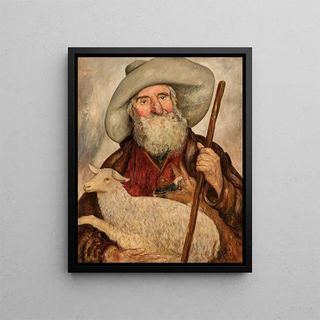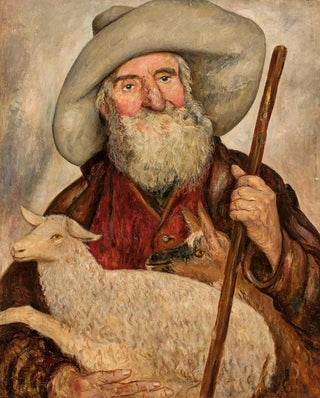Art print | Good Shepherd - Tadeusz Makowski


View from behind

Frame (optional)
In the fascinating world of art, some works transcend the mere frame to become windows into deep emotions and timeless stories. "Bon berger - Tadeusz Makowski" is one of those creations that, through its aesthetics and symbolism, invites the viewer on an inner journey. This piece evokes harmony between man and nature, a relationship imbued with tenderness and serenity. Contemplating this work, one is immediately transported to a world where everyday life blends with poetry, where every detail tells a story. The soft light bathing the scene and the delicately sketched characters immerse us in a suspended moment, an invitation to reflection and contemplation.
Style and uniqueness of the work
Tadeusz Makowski's style is characterized by a unique sensitivity, combining pictorial tradition with a modern approach. In "Bon berger," the choice of pastel colors and rounded shapes creates a warm and soothing atmosphere. The characters, though stylized, exude palpable humanity, an emotional connection that touches the heart. The artist uses subtle contrasts between shadows and light to emphasize the depth of the scene, while maintaining a lightness that characterizes his work. This piece also stands out for its ability to evoke universal themes such as protection, peace, and the simplicity of rural life. Every brushstroke seems to dance on the canvas, inviting the viewer to immerse themselves in this universe filled with softness and delicacy.
The artist and his influence
Tadeusz Makowski, Polish artist of the early 20th century, managed to mark his era with his innovative style and artistic vision. Influenced by the artistic movements of his time, he integrated elements of Fauvism and Cubism while preserving a distinct identity. His work reflects his personal journey, oscillating between his Polish cultural heritage and the influences he encountered during his stays in Paris. Makowski captured the essence of everyday life with rare poetry, transforming ordinary scenes into moments of grace. His influence endures, inspiring many contemporary artists who see

Matte finish

View from behind

Frame (optional)
In the fascinating world of art, some works transcend the mere frame to become windows into deep emotions and timeless stories. "Bon berger - Tadeusz Makowski" is one of those creations that, through its aesthetics and symbolism, invites the viewer on an inner journey. This piece evokes harmony between man and nature, a relationship imbued with tenderness and serenity. Contemplating this work, one is immediately transported to a world where everyday life blends with poetry, where every detail tells a story. The soft light bathing the scene and the delicately sketched characters immerse us in a suspended moment, an invitation to reflection and contemplation.
Style and uniqueness of the work
Tadeusz Makowski's style is characterized by a unique sensitivity, combining pictorial tradition with a modern approach. In "Bon berger," the choice of pastel colors and rounded shapes creates a warm and soothing atmosphere. The characters, though stylized, exude palpable humanity, an emotional connection that touches the heart. The artist uses subtle contrasts between shadows and light to emphasize the depth of the scene, while maintaining a lightness that characterizes his work. This piece also stands out for its ability to evoke universal themes such as protection, peace, and the simplicity of rural life. Every brushstroke seems to dance on the canvas, inviting the viewer to immerse themselves in this universe filled with softness and delicacy.
The artist and his influence
Tadeusz Makowski, Polish artist of the early 20th century, managed to mark his era with his innovative style and artistic vision. Influenced by the artistic movements of his time, he integrated elements of Fauvism and Cubism while preserving a distinct identity. His work reflects his personal journey, oscillating between his Polish cultural heritage and the influences he encountered during his stays in Paris. Makowski captured the essence of everyday life with rare poetry, transforming ordinary scenes into moments of grace. His influence endures, inspiring many contemporary artists who see






